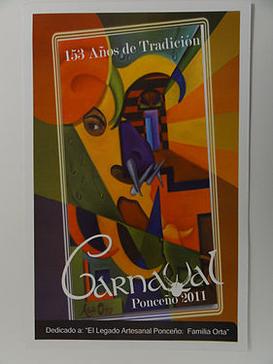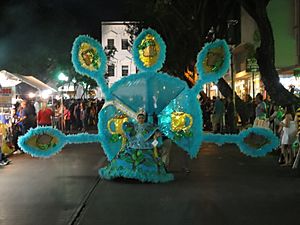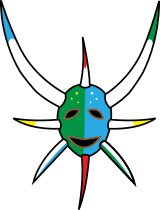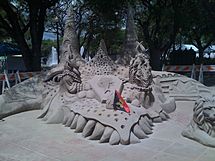Carnaval de Ponce facts for kids
Quick facts for kids Carnaval de Ponce |
|
|---|---|

Poster bill of the 2011 Carnaval de Ponce, celebrated 2–8 March 2011, in Ponce, Puerto Rico.
|
|
| Official name | Carnaval Ponceño |
| Also called | Carnaval de Ponce |
| Type | Local, cultural |
| Celebrations | Parades, parties, dances, music, food |
| Date | Week before Ash Wednesday |
| 2024 date | 14-17 February |
| 2025 date | 21 February – 4 March |
| Frequency | Annual |
| First time | 1858 |
| Related to | Lent |
The Carnaval de Ponce, also known as the Ponce Carnival, is a huge, colorful festival held every year in the city of Ponce, Puerto Rico. This exciting celebration is one of the oldest in the Western Hemisphere. It has been a tradition since 1858!
The festival lasts for one week and ends on the day before Ash Wednesday. This is a Christian holiday that marks the beginning of Lent. Because of this, the carnival usually takes place in February or March. It's a famous event that attracts around 100,000 people each year.
The Ponce Carnival is similar to other famous carnivals around the world, like Mardi Gras in New Orleans and the carnivals in Venice and Rio de Janeiro.
Contents
History of the Carnival
The Ponce Carnival began in 1858. It was started by a Spaniard named José de la Guardia, who held a masked dance. This masquerade ball became a yearly tradition.
In the 1950s, the city's government added a parade to the celebration. By the 1960s, the parade grew to include large, decorated floats. These floats represented local schools, businesses, and community groups.
Some people believe the carnival's traditions came from Barcelona, Spain. Immigrants may have brought the celebration to Ponce. Over time, the people of Ponce added their own special touches. They included Afro-Antillean music, which brings a lot of happy, rhythmic drum sounds to the party.
In 1995, the Ponce Carnival was even featured in the Puerto Rican Day Parade in New York City. A group of over 200 performers from Ponce marched down Fifth Avenue, sharing their traditions with the world.
Costumes and Masks
A key part of the carnival is the vejigante. Vejigantes are playful characters who wear colorful costumes and scary-looking masks. Their costumes are meant to look like mischievous devils.
The vejigante masks are a famous symbol of Puerto Rican art. They are made from paper-mâché, which is a mix of newspaper and glue. The masks are known for having many horns. Artisans in Ponce have been making these unique masks for over 100 years.
During the parades, vejigantes run around and playfully hit people with blown-up cow bladders. The bladders make a loud noise when they hit something, adding to the fun and excitement of the carnival.
The Burial of the Sardine
The carnival ends with a funny ceremony called the "Burial of the Sardine." This event started in 1967. A fake sardine is put in a coffin and carried through the streets in a pretend funeral parade.
Everyone pretends to be sad, but it's all for fun. The burial marks the end of the party. People sing a song that says the carnival is over, but it will come back again next year.
The Carnival is dead now
They are burying him;
Throw just a little dirt in
So he can rise again.
Schedule of Events
The carnival is a week-long party with something happening every day. Here is a typical schedule:
- Wednesday: Vejigantes Party
- Thursday: King Momo's Entrance Parade
- Friday: Crowning of the Child Queen
- Saturday: Crowning of the Carnival Adult Queen
- Sunday: The Main Parade
- Monday: Carnival's Ball Dance
- Tuesday: Burial of the Sardine
Carnival Queens
Since 1959, an adult queen has been chosen to represent the carnival. In 1973, the tradition of choosing a child queen also began.
| Queens of the Carnival | |
|---|---|
| Year | Queen Name |
| 1959 | Leida Luz Llorens |
| 1960 | Leida Luz Llorens |
| 1961 | Leida Luz Llorens |
| 1962 | Esther Noriega |
| 1963 | Edna Ivette Grau |
| 1964 | Edna Ivette Grau |
| 1965 | Ivonne Maria Santiago |
| 1966 | Carmencita Lespier |
| 1967 | Milagros Agostini |
| 1968 | Carmen Milagros Rivera |
| 1969 | Mildred Goyco |
| 1970 | Mayra Irizarry |
| 1971 | Cinthia Boscio |
| 1972 | Gisela Irizarry |
| 1973 | Maria de los Angeles Colon |
| 1974 | Lourdes Maria Rovira |
| 1975 | Alma Minerva Ortiz |
| 1976 | Lourdes Falcon |
| 1977 | Marlene Delgado Brey |
| 1978 | Lourdes Milagros Buzo |
| 1979 | Johanna Bonaparte Duran |
| 1980 | Mariposa Zayas Burgos |
| 1981 | Elizabeth Morales |
| 1982 | Sonja Johanna Maiz Iñesta |
| 1983 | Angeles I. Nieves |
| 1984 | Rayna Judith Rivera Fernandez |
| 1985 | Patricia Rovira Vechini |
| 1986 | Natalia Rodriguez Deynes |
| 1987 | Sonia Farinacci Morales |
| 1988 | Awilda Lopez Cepero |
| 1989 | Geraldina Ann Vidal Cavas |
| 1990 | Brenda I. Rivera |
| 1991 | Elsie M. Velez Miranda |
| 1992 | Elaina Rodriguez Spenser |
| 1993 | Virmarie Figueroa Rodriguez |
| 1994 | Maria de los Angeles Buzo |
| 1995 | Raqueline Martinez Uriarte |
| 1996 | Leslie Bermejo Velazquez |
| 1997 | Eugenik Gonzalez de Leon |
| 1998 | Yara M. Velazquez Rivera |
| 1999 | Miheydic Rodriguez Georgi |
| 2000 | Ludmila del Carmen Pagan Ocasio |
| 2001 | Luzmarie Borrero Rodriguez |
| 2002 | Karen Marie Molina |
| 2003 | Robelyn Caraballo Ramirez |
| 2004 | Miraida Rodriguez Muniz |
| 2005 | Anabeliz Alindato Figueroa |
| 2006 | Pamela Sierra Rivera |
| 2007 | Vilmarie Reyes Flores |
| 2008 | Christal J. Ponce Roman |
| 2009 | Alisheanne Santiago Coll |
| 2010 | Xiomara Ramirez Rodriguez |
| 2011 | Solymar Feliciano Montero |
| 2012 | Christal Nicole Gonzalez Rivera |
| 2013 | Stephanie Echevarría Llanes |
| 2014 | Glorymar Batista Rivera |
| 2015 | Keishla N. Rodriguez de Jesus |
| 2016 | Keishla Marie Correa Dides |
| 2017 | Maytes L. Rivera Vargas |
| 2018 | Maytes L. Rivera Vargas |
| 2019 | Adlin Camille Mendez Vargas |
| 2020 | Kayra Figueroa de Jesús |
| 2021 | Kayra Figueroa de Jesus |
| 2022 | Julianna Elis Guilbe Serrano |
| Child Queens of the Carnival | |
|---|---|
| Year | Child Queen Name |
| 1973 | Maribel Primera |
| 1974 | Shelly de la Concha |
| 1975 | Ainee Rodriguez Gonzalez |
| 1976 | Lynette Rosado Colon |
| 1977 | Janice Vanessa Torres Torres |
| 1978 | Marilyne Capote |
| 1979 | Elizabeth Lopez |
| 1980 | Monica Yadira Rosado Plascencia |
| 1981 | Jeanette Santiago |
| 1982 | Emma Raquel Gordian Vega |
| 1983 | Bethzaida Rodriguez Velez |
| 1984 | Michelle Lopez Asencio |
| 1985 | Jessica Linette Castro Vidal |
| 1986 | Solange Isabel de Lahongrais Taylor |
| 1987 | Lucila I. Chardon Penna |
| 1988 | Jeniffer Denice Luna Doiu |
| 1989 | Fremiotte J. Rugual Garcia |
| 1990 | Maria Mercedes Armstrong |
| 1991 | Diriee Y. Rodriguez |
| 1992 | Melissa A. Lajara Silva |
| 1993 | Luz M. Borrero Rodriguez |
| 1994 | Jonaida A. Oliveras Pabon |
| 1995 | Zuleika M. Roque Vargas |
| 1996 | Carla Michelle |
| 1997 | Lillie M. Rodriguez Clavell |
| 1998 | Francheska Rodriguez Sopeña |
| 1999 | Karely M. Velez Carlo |
| 2000 | Glorimar Batista Rivera |
| 2001 | Stephania M. Rivera San Antonio |
| 2002 | Christal J. Ponce Roman |
| 2003 | Jennifer M. Rivera San Antonio |
| 2004 | Layla N. Velazquez Rivera |
| 2005 | Christal M. Velez Carlo |
| 2006 | Aida I. Garcia Munoz |
| 2007 | Joymar Ramirez Villadares |
| 2008 | Marisabel Montalvo Ruiz |
| 2009 | Betimar Alcala Cintron |
| 2010 | Naomi Mercado Cordero |
| 2011 | Gabriela Bonilla Duque |
| 2012 | Sullymar Rangel Maldonado |
| 2013 | Dayivette Díaz Rosado |
| 2014 | Joanne M. Ruberté Rivera |
| 2015 | Jomary A. Ruberté Rivera |
| 2016 | Jamillys G. Santiago Feliciano |
| 2017 | Alanis M. Torres Irizarry |
| 2018 | Alanis M. Torres Irizarry |
| 2019 | Gloriangely Velez Batista |
| 2020 | Allyson Soley Sánchez Pérez |
| 2021 | Allison Sanchez Perez |
| 2022 | Jenny Liann Vazquez Belfort |
See also
 In Spanish: El Carnaval de Ponce para niños
In Spanish: El Carnaval de Ponce para niños
- Feria de Artesanías de Ponce
- Ponce Jazz Festival
- Fiesta Nacional de la Danza
- Día Mundial de Ponce
- Festival Nacional de la Quenepa
- Bienal de Arte de Ponce
- Festival de Bomba y Plena de San Antón
- Carnaval de Vejigantes
- Festival Nacional Afrocaribeño




